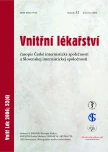Trimetazidine in the treatment of stable angina pectoris TRIADA – (TRImetazidine in stable Angina twice Daily)
Authors:
V. Chaloupka
Authors‘ workplace:
Interní kardiologická klinika Lékařské fakulty MU a FN Brno, pracoviště Bohunice, přednosta prof. MUDr. Jindřich Špinar, CSc., FESC
Published in:
Vnitř Lék 2006; 52(6): 609-614
Category:
Original Contributions
Overview
The primary objective of the national study TRIADA was to evaluate the efficacy and tolerability of Preductal MR (trimetazidine) at a dose of 35 mg twice daily which was added to current therapy involving the maximum of two antianginal drugs. The outcome was evaluated after 12 weeks of therapy and compared with baseline data. The study included 74 patients with stable exertional angina pectoris (AP) and positive exercise testing results. Trimetazidine (Preductal MR) at a dose of 35 mg twice daily was added to their current therapy involving two drugs at most. TRIADA confirmed that the use of trimetazidine in a new pharmacological form is effective and well tolerated in the treatment of angina pectoris. The study also confirmed a beneficial effect of trimetazidine on the incidence of angina pectoris paroxysms and objective manifestations of ischaemia during exercise testing. Holter monitoring clearly showed that metabolic therapy added to standard antianginal therapy would reduce the incidence of symptomatic and asymptomatic ischaemia. In addition, 12-week therapy with trimetazidine helped improve all end points of quality of life of AP patients evaluated using a questionnaire for AP patients (The Seattle Angina Questionnaire).
Key words:
Angina pectoris – Antianginal therapy – Quality of life – Trimetazidine
Sources
1. Lopaschuk GD. Pharmacologic rationale for trimetazidine in the treatment of ischemic heart disease. Am J Cardiovasc Drugs 2003; 3(Suppl I): 21-26.
2. Kantor P, Lucien A, Kozak R et al. The antianginal drug trimetazidine shifts cardiac energy metabolism from fatty acid oxidation to glucose oxidation by inhibiting mitochondrial long-chain 3-ketoacyl coenzyme A thiolase. Circ Res 2000; 86: 580-588.
3. Marzilli M, Klein WW. Efficacy and tolerability of trimetazidine in stable angina: a meta-analysis of randomized, double-blind, controlled trials. Cor Artery Dis 2003; 14: 171-179.
4. Manchanda SC, Krishnaswami S. Combination treatment with trimetazidine and diltiazem in stable angina pectoris. Heart 1997; 78: 353-357.
5. Levy S and Group of South of France Investigators. Combination therapy of trimetazidine with diltiazem in patients with coronary artery disease. Am J Cardiol 1995; 76: 12B-16B.
6. Szwed H, Sadowski Z, Elikowski W et al. Combination treatment in stable effort angina using trimetazidine and metoprolol. Results of randomized, double-blind, multicentre study (TRIMPOL II). Eur Hear J 2001; 22: 2267-2274.
7. Hradec J, Filipová J TRIKET I a II (TRImetazidin v Kombinaci s Existující Terapií). Výsledky české a slovenské multicentrické studie u 320 nemocných se stabilní námahovou anginou pectoris. Cor Vasa 2001; 43: 436-442.
8. Spertus JA, Winder JA, Dewhurst TA et al. Development and evaluation of the Seattle Angina Questionnaire: a new functional status measure for coronary artery disease. J Am Coll Cardiol 1995; 25: 333-341.
9. Bultas J. Léčba anginy pectoris. Jak dnes, jak zítra? Medicína po promoci 2004; 5: 14-30.
10. Hradec M, Chaloupka V, Sachová M. Angina Treatment Patterns Survey: Současný stav diagnostiky a léčby nemocných se stabilní anginou pectoris v České republice. Cor Vasa 2003; 45: 173-180.
11. Packer M. Combined beta-adrenergic and calcium-entry blockade in angina pectoris. N Engl J Med 1989; 320: 709-718.
12. Savonitto S, Ardissino D, Egstrup K et al. Combination therapy with metoprolol and nifedepine versus monotherapy in patients with stable angina pectoris. International Multicenter Angina Exercise (IMAGE) Study. J Am Coll Cardiol 1996; 27: 311-316.
13. Kolbel F, Bada V. Trimetazidine in geriatric patients with stable angina pectoris: The Tiger Study. Int J Clin Pract 2003; 57: 867-870.
Labels
Diabetology Endocrinology Internal medicineArticle was published in
Internal Medicine

2006 Issue 6
Most read in this issue
- Nuclear receptors PPARα
- Prevalence and causes of reflux in deep venous system of the leg in patients with insufficiency of superficial veins
- Sustained monomorphic ventricular tachycardia in patients with structural heart disease. Different arrhythmogenic substrates, different options of palliative and curative treatment in the era of three-dimensional mapping
- Molecular genetic diagnostics and screening of hereditary hemochromatosis
